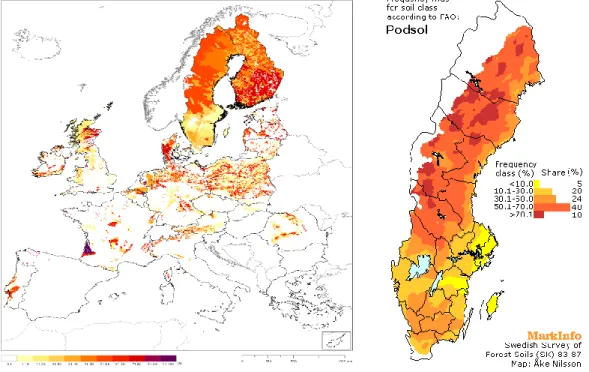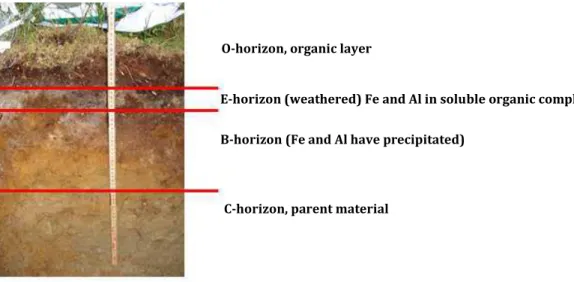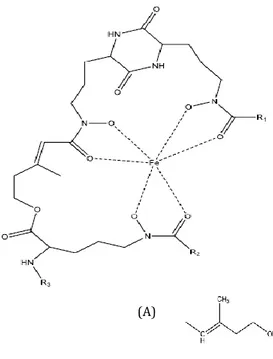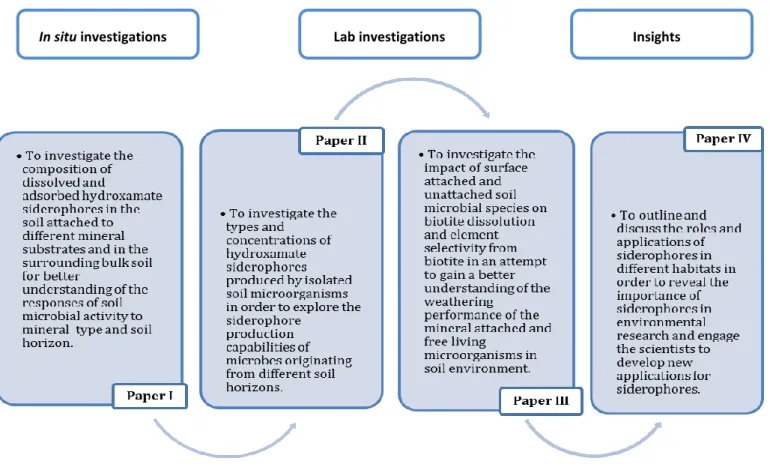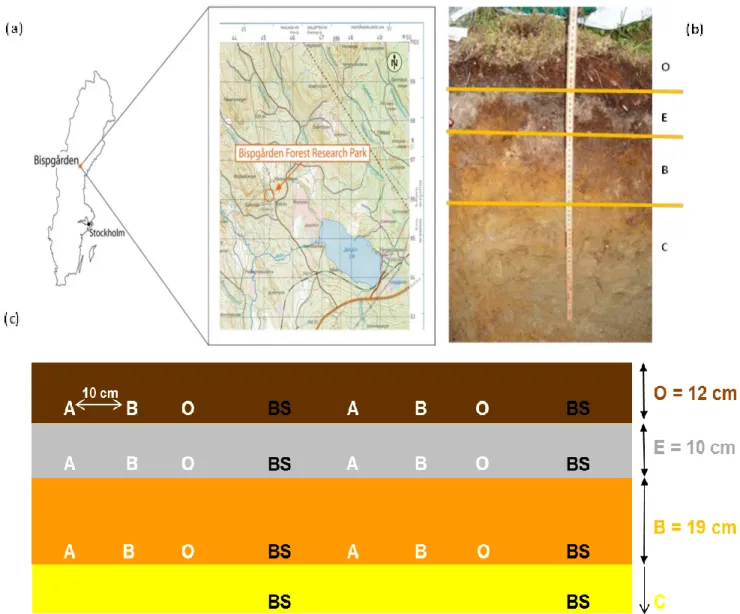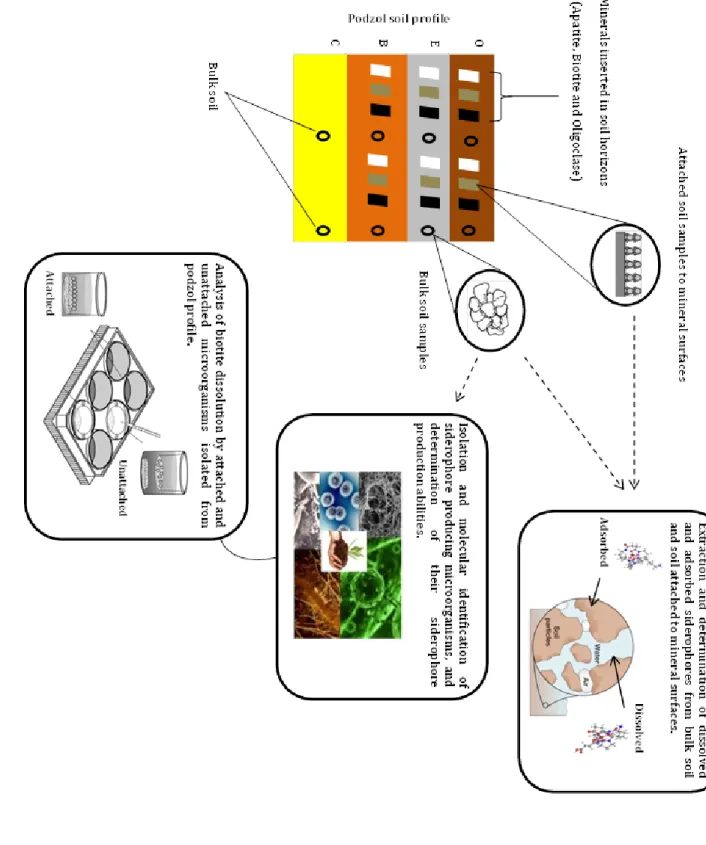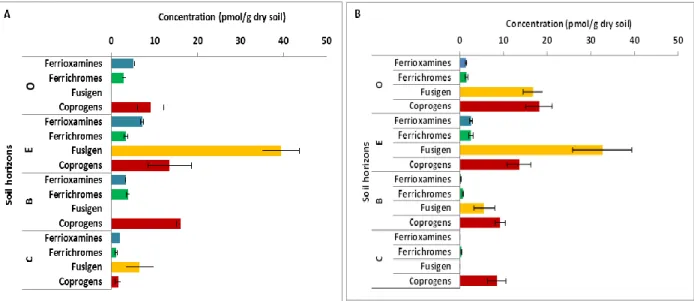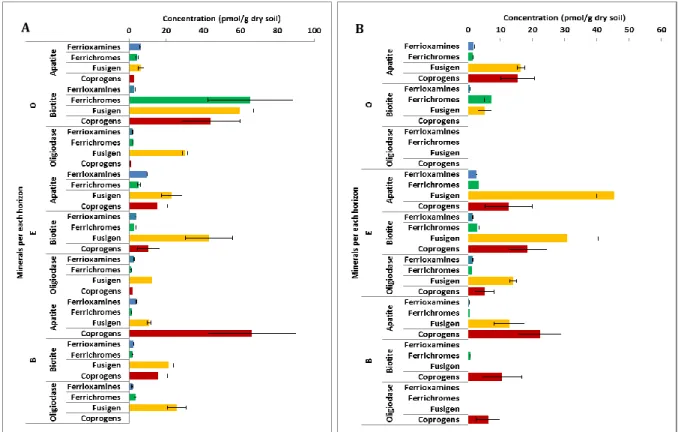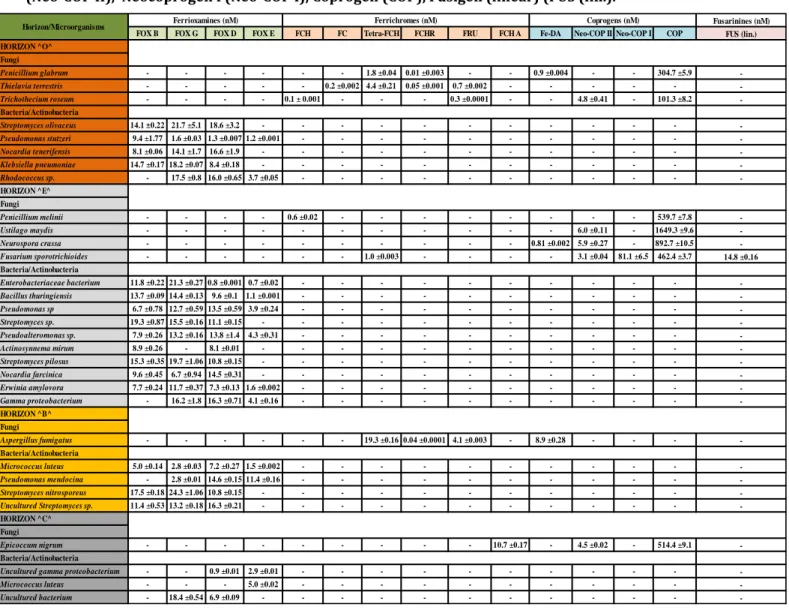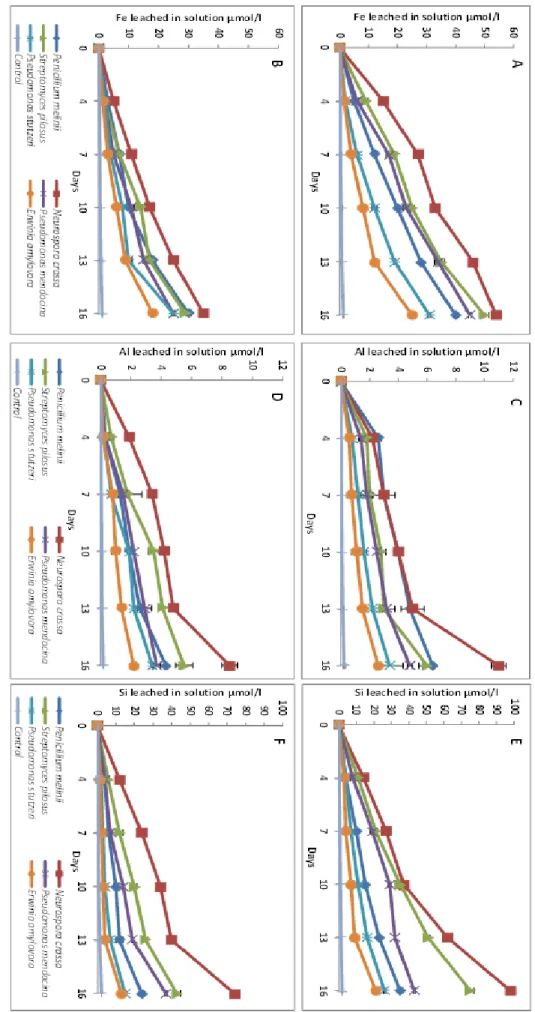M E D D E L A N D E N f r å n S T O C K H O L M S U N I V E R S I T E T S I N S T I T U T I O N f ö r G E O L O G I S K A V E T E N S K A P E R N o . 3 5 8
Microbe-mineral interactions in soil
Investigation of biogenic chelators, microenvironments and weathering processes
Engy Ahmed
Stockholm, May 2015
Department of Geological Sciences
Stockholm University
SE-106 91 Stockholm
Sweden
©Engy Ahmed, Stockholm University 2015 ISBN 978-91-7649-135-5
Printed in Sweden by Holmbergs, Malmö 2015 Distributor: Department of Geological Sciences Cover: forest picture by Cajsa Lithell.
To my parents and brother Thanks for your endless love
A dissertation for the Degree of Doctor of philosophy in Natural Science
Engy Ahmed
Department of Geological Sciences
Stockholm University, SE-106 91, Stockholm, Sweden
Abstract
The interplay between geology and biology has shaped the Earth during billions of years. Microbe-mineral interactions are prime examples of this interplay and underscore the importance of micro-organisms in making Earth a suitable environment for all forms of life. The present thesis takes an interdisciplinary approach to obtain an integrated understanding of microbe-mineral interactions. More specifically it addresses how the composition and distribution of biogenic chelators (sidero-phores) differ with regard to soil horizon and mineral type in situ, what siderophore type soil mi-croorganisms produce under laboratory conditions, what role microbial surface attachment plays in mineral weathering reactions and what central roles and applications siderophores have in the environment.
Podzol, the third most abundant soil in Europe and the most abundant soil in Scandinavia, was cho-sen for a field experiment, where three mineral types (apatite, biotite and oligoclase) were inserted in the organic, eluvial and upper illuvial soil horizons. The study started with an investigation of the siderophore composition in the bulk soil profile and on the mineral surfaces (Paper I), which was followed by a study of the siderophore producing capabilities of microorganisms isolated from the soil profile under laboratory conditions (Paper II). Subsequently, a study was done on the impact of microbial surface attachment on biotite dissolution (Paper III). Finally, the roles of siderophores in nature and their potential applications were reviewed (Paper IV).
The major findings were that the concentration of hydroxamate siderophores in the soil attached to the mineral surfaces was greater than those in the surrounding bulk soil, indicating that the minerals stimulate the microbial communities attached to their surfaces to produce more siderophores than the microorganisms in the bulk soil. Each mineral had a unique assemblage of hydroxamate siderophores that makes the mineral type one of the main factors affecting siderophore composition in the natural environment. Siderophore production varied between the microbial species originating from different soil horizons, suggesting that the metabolic properties of microbes in deep soil horizons function differently from those at upper soil horizons. Microbial surface attachment enhanced the biotite dissolution, showing that attached microbes have a greater influence than free living populations on weathering reactions in soil. In conclusion, our findings reflected that the complicated relationship between microorganisms and mineral surfaces reinforces the central theme of biogeochemistry that the mineral controls the biological activity in natural environments. However, the importance of these relationships to the overall biogeochemical systems requires further investigation.
A dissertation for the Degree of Doctor of philosophy in Natural Science
Engy Ahmed
Department of Geological Sciences
Stockholm University, SE-106 91, Stockholm, Sweden
Sammanfattning
Samspelet mellan geologi och biologi har format jorden under miljarder år. Mikrob-mineral interaktioner är ett exempel på detta samspel och framhåller betydelsen av mikroorganismers roll i att göra jorden till en beboelig miljö för olika former av liv. Denna avhandling tar ett tvärvetenskaplig angreppssätt för att få en samordnad förståelse av mikrob-mineral interaktioner. Mer specifikt avhandlas hur sammansättningen och fördelningen biogena kelatorer, ”sideroforer”, som främjar vittring, skiljer sig beroende på jordhorisont och typ av mineral in situ, vilka typer av sideroforer som marklevande mikroorganismer producerar under laboratorieförhållanden, vilken betydelse kontakten mellan mineralytor och mikrober har i vittringen av mineraler. Dessutom beskrivs potentiella applikationer av sideroforer i tillämpat miljöarbete.
Podsol som är den tredje vanligast förekommande jordtypen i Europa och den vanligast förekommande i Skandinavien valdes för ett fältexperiment där tre typer av mineraler (apatit, biotit och oligoklas) placerades i den organiska, i den eluviala och i den övre illuviala jordhorisonten. Studien inleddes med en undersökning av sammansättningen av sideroforer i jord adsorberad till mineralytorna och i den omgivande jorden (Artikel I). Därpå följde en undersökning av förmågan hos marklevande mikroorganismer som isolerats från jordprofilen att producera sideroforer under laboratorieförhållanden (Artikel II). Därefter gjordes en studie av betydelsen av kontakten mellan mineralyta och mikroorganismer i vittring av biotit (Artikel III). Slutligen granskades betydelsen av sideroforer i naturen och dess potentiella tillämpningar (Artikel IV). De viktigaste resultaten var att koncentrationen av hydroxamat-sideroforer i jord som var adsorberad till mineralytorna var högre än koncentrationen i den omgivande jorden, vilket pekar på att mineralerna stimulerar de mikrobiella samhällena som lever i nära kontakt med mineraler att producera mer sideroforer än mikroorganismer i den omgivande jorden. Varje typ av mineral hade en unik uppsättning av hydroxamat-sideroforer, vilket indikerar att mineraltypen är en av de viktigaste faktorerna som påverkar sammansättningen av sideroforer i naturliga miljöer. Sideroforproduktionen hos isolaten varierade beroende på vilken jordhorisont mikroorganismerna härstammade från, vilket tyder på att dessa adapterats för att fungera optimalt i de geokemiska förhållanden som råder i deras hemma-horisont. En nära kontakt mellan mikrober och mineral förbättrade upplösningen av biotit, vilket visar att mikroorganismer i direkt kontakt med mineralen har en större påverkan på vittrings reaktioner än ”fritt” levande populationer. Sammanfattningsvis återspeglar våra resultat att det komplicerade förhållandet mellan mikroorganismer och mineralytor förstärker det centrala temat i biogeokemi att mineraler har stor inverkan på den biologiska aktiviteten i naturliga miljöer. Betydelsen av dessa samband i de biogeokemiska systemen kräver dock ytterligare utredning.
Microbe-mineral
interactions
in soil
Investigation of biogenic chelators, microenvironments and weathering processes
Engy Ahmed
Department of Geological Sciences, Stockholm University, SE-106 91, Stockholm, Sweden
This doctoral thesis consists of a summary and four published articles. Paper I:
Ahmed E., and Holmström S.J.M. (2014). The effect of soil horizon and mineral type on the
distribu-tion of siderophores in soil. Geochim. Cosmochim. Acta 131, 184-195. Doi:10.1016/j.gca.2014.01.031.
Paper II:
Ahmed E., and Holmström S.J.M. (2015). Siderophore production by microorganisms isolated from
a podzol soil profile. Geomicrobiology Journal, in press. Doi:10.1080/01490451.2014.925011. Paper III:
Ahmed E., and Holmström S.J.M. (2015). Microbe-mineral interactions: the impact of surface
at-tachment on mineral weathering and element selectivity by microorganisms. Chemical Geology 403, 13–23. Doi:10.1016/j.chemgeo.2015.03.009.
Paper IV:
Ahmed E., and Holmström S.J.M. (2014). Siderophores in environmental research: roles and
appli-cations. Microbial Biotechnology 7, 196-208. Doi:10.1111/1751-7915.12117.
The following papers are not included as a part of this thesis:
Schütze E., Ahmed E., Voit A., Klose M., Greyer M., Svatoš A., Merten D., Roth M., Holmström S.J.M., Kothe E. (2015). Siderophore production by streptomycetes - Stability and alteration of ferrihy-droxamates in heavy metal contaminated soil. Environmental Science and Pollution Research, in press. Doi:10.1007/s11356-014-3842-3.
Esposito A., Ahmed E., Ciccazzo S., Sikorski J., Overman J., Holmström S.J.M., Brusetti L. (2015). Comparison of rock varnish bacterial communities with surrounding non-varnished rock surfaces: Taxon-specific analysis and morphological description. Microbial Ecology, in review.
Contents
1. Introduction.……… 8
1.1 Podzol soil……… 8
1.2 Mineral weathering by soil microorganisms……… 9
1.3 Microbial siderophores in soil ecosystem……… 10
2. Scope of the thesis……… 13
3. Sampling site and field experiment set up……… 14
4. Summary of materials and methods……… 15
4.1 Extraction of siderophores from soil and microbial isolates………. 15
4.2 Isolation and molecular identification of siderophore producing microorganisms from soil 15
4.3 Quantification of siderophores using HPLC-ESI-MS 15
4.4 Biotite weathering by attached and unattached soil microorganisms 16
4.5 Data analysis and statistics 16
5. Summary and discussion of major findings……… 18
5.1 What is the impact of soil horizon and mineral type on siderophore composition in soil? 18...
5.2 What siderophore types are produced by soil microorganisms?... 20
5.3 What is the role of microbial surface attachment in mineral weathering reactions? 22
6. Overview of the potential roles and applications of siderophores…… 26
7. Conclusion and future prospective……… 27
Acknowledgements……… … 29
1. Introduction
Soil is a heterogeneous system that consists of a variety of microhabitats with different physico-chemical properties and discontinuous environmental conditions (Havlicek, 2012). Mineral nutri-ents are cycled between living and dead organic componnutri-ents of soil, and mineral weathering is a primary source of most of the essential elements for microorganisms and plants (Gadd, 2013). Soil microorganisms influence weathering through physical and chemical processes (Banfield et al., 1999). One of the main chemical processes used by most soil microorganisms is the production of siderophores as metal chelating agents (Schwyn and Neilands, 1987).
Up to the present, most studies have focused on investigating mineral weathering under laboratory conditions, and only a few studies have reported the biogenic chelator concentrations in natural soil. The present thesis takes an interdisciplinary approach to obtain a comprehensive understand-ing of microbe-mineral interactions in the podzol forest soil. Field experiments have been conduct-ed to explore the composition and distribution of siderophores in a soil profile and on different mineral substrates. In addition, laboratory investigations have been conducted linking siderophore production capabilities and microbial surface attachment efficiency of soil microorganisms to min-eral weathering reactions. The main hypothesis is that the minmin-eral type controls the activity of soil microbial communities. Furthermore the nature of the microbe-mineral interaction affects the weathering capacity and element selectivity of the microorganisms.
1.1 Podzol soil
Podzol soils cover approximately 485 million hectares worldwide and are located mainly in the temperate and boreal regions of the Northern Hemisphere (Lundström et al., 2000). Podzol is the third most abundant soil in Europe, covering more than 0.5 million km2 or 14% of its total area (Figure 1). This reference soil group is present in 22 member states of the EU and is only absent in Hungary, Slovenia, Bulgaria, Malta and Cyprus. Vast areas of podzols are found in the Scandinavian countries; for example they cover approximately 14 M ha or 60% of the forest land area of Sweden (Figure 1).
A typical podzol profile consists of a litter layer (O), a leached ash gray eluvial mineral layer (E), an accumulation (illuvial) layer of organic matter in combination with Fe and Al (B) and the parent material (C) (Figure 2). Podzol soils are typically acidic throughout the profile with the lowest pH values in the O-horizon and an increasing pH with depth (Fritze et al., 2000). The O-horizon con-tains various organic acids like fulvic acids, humic acids, low molecular mass organic acids (LMMO-As) and other chelating agents which are produced mainly by soil biota and decaying plant litters (Lundström et al., 2000; Holmström et al., 2004; van Scholl et al., 2006; Winkelmann, 2007). These organic acids and chelating agents are leached downwards into the underlying E-horizon to pro-mote the weathering of primary minerals by ion-exchange, dissolution and formation of metal-organic complexes (Jongmans et al., 1997; van Breemen et al., 2000; Eriksson et al., 2005). When the primary minerals dissolve, their surface color turns gray, which is the main reason for the char-acteristic pale ash color of the E-horizon (Sauer et al., 2007). The weathering products are trans-ported downward with the percolating soil solution, making the E-horizon very poor in nutrients (Eriksson et al., 2005). As the soil solution percolates farther down in the soil profile, Al and Fe in complex with organic compounds are precipitated and accumulated in the B-horizon (Lundström et al., 2000). There are three main reasons for the precipitation and accumulation in the B-horizon (Buurman and Jongmans, 2005): a) weathering of silicate minerals that leads to the formation and precipitation of allophanic material, b) migration of metal-organic complexes down the soil profile, and c) decomposition of the metal-organic complexes and release of Fe and Al and their subsequent precipitation as sesquioxides which may be responsible for the reddish brown color of the B-horizon. Compared with the E-horizon, the B-horizon contains higher levels of both nutrients and organic matter (Buurman and Jongmans, 2005). Finally, the C-horizon is overlies the bedrock, which is commonly granite and gneiss (FAO, 1990).
Figure 2. Description of podzol soil profile of the study area (Bispgården Forest Research Park).
1.2 Mineral weathering by soil microorganisms
Mineral weathering is important for understanding a variety of environmental issues such as nutri-ent cycling, neutralization of acidic rain and long-term sequestration of atmospheric CO2 (Drever and Hurcomb, 1986; Berner and Berner, 1997; Huntington et al., 2000). Soil microorganisms play an essential role in releasing the key nutrients from primary minerals that are required for their own and plants’ nutrition (Uroz et al., 2009). Microorganisms can directly or indirectly enhance mineral dissolution, disaggregation and secondary mineral formation (Finlay et al., 2009). Microbi-al attachment to minerMicrobi-al surfaces leads directly to the formation of a low pH microenvironment
O-horizon, organic layer
E-horizon (weathered) Fe and Al in soluble organic complexes B-horizon (Fe and Al have precipitated)
that contains extracellular polymers. This increases the water retention time on the mineral surface and the diffusion of ions away from the mineral; therefore it increases mineral dissolution and en-hances secondary mineral production (Banfield et al., 1999; Liermann et al., 2000; Ojeda et al., 2006). In these microenvironments, mineral nutrients can be chelated directly from the soil miner-als or shared amongst the surrounding microorganisms (Rogers and Bennett, 2004). The surface attached microorganisms contribute to mineral dissolution by using different mechanisms such as lowering pH, complexing with surface ions, catalyzing redox reactions and by physical forcing (Brown et al., 1999; Rogers et al., 1998; Rogers et al., 2001; Bennett et al., 2001). The unattached microorganisms that live as individuals or in aggregates in the soil solution, on the other hand, ob-tain their element nutrition mainly by complexing with ions and oxido-reduction reactions (Madi-gan et al., 2000).
The production of biogenic chelators is considered to be one of the most important weathering mechanisms by all soil microorganisms. The chelators can either complex with ions on the mineral surface and weaken the metal–oxygen bonds or alternatively complex with ions in solution, thereby decreasing solution saturation state (Banfield et al., 1999; Finlay et al., 2009). The most common biogenic chelators produced by microorganisms are siderophores and LMMOAs. Siderophores form 1:1 complexes with Fe(III), with stability constants ranging between K=1022 and K=1052 (Jalal and van der Helm, 1991; Matzanke, 1991), while the stability constants of LMMOAs like oxalic and citric acids with Fe(III) are only K=107.6 and 1012.3, respectively (Perrin, 1979). Thus, the impact of sider-ophores on soil mineral weathering is more effective than LMMOAs. However, when both LMMOAs and siderophores are present they may function synergistically, which results in a higher mineral dissolution rate compared to that of the siderophore only (Reichard et al., 2007).
There are several mechanisms for siderophore promoted Fe-bearing mineral dissolution in soil (e.g., Holmén and Casey, 1996; 1998). The general mechanism is that a Fe-siderophore complex is formed at the mineral surface and is subesquently transferred into the surrounding soil solution, thereby becoming available for uptake by the cell membrane of microorganisms or plants (Kali-nowski et al., 2000a; Liermann et al., 2000; Kraemer, 2004). Siderophores are either recycled or destroyed upon Fe reduction. The reduced iron Fe(II) that is not used by the cell can act as an elec-tron donor in elecelec-tron transport chains (Kalinowski et al., 2000b). On the other hand, LMMOAs could promote the dissolution of minerals directly through three mechanisms: by altering the dis-solution rate far from equilibrium through decreasing dis-solution pH, by forming complexes with cati-ons at mineral surface, and by affecting the saturation state and speciation of icati-ons in solution (Drever and Stillings, 1997).
1.3 Microbial siderophores in soil ecosystem
Fe is an important element for the growth of almost all living microorganisms since it acts as a cata-lyst in various enzymatic processes, oxygen metabolism, electron transfer, and DNA and RNA syn-thesis (Touati, 2000; Verkhovtseva et al., 2001). Thus, microorganisms have developed specific Fe uptake strategies like siderophores. Siderophores (Greek: “iron carriers”) are defined as low mo-lecular mass chelating agents produced by bacteria and fungi growing under Fe-limiting condition (Neilands, 1995). The main role of siderophores is to scavenge Fe from the environment and make it available to the microbial cell (Kraemer, 2004). Microorganisms can produce both extracellular and intracellular siderophores. Extracellular siderophores contribute in the solubilization and transportation of Fe from environments to microbial cells, while intracellular siderophores are responsible for storage of Fe inside the cells (Wilhelm and Trick, 1994). Bacteria produce four groups of siderophores (catecholates, carboxylates, hydroxamates “ferrioxamines only” and mixed
siderophores) (Matzanke, 1991), while fungi produce mainly hydroxamates (i.e. ferrichromes, coprogens and fusarinines) (Winkelmann, 2007).
Hydroxamates are the most common group of siderophores in natural environments. They form 1:1 complexes with Fe(III) and the stability constants are in the range of K=1022 to K=1033 (Robert and Chenu, 1992). Fe-hydroxamate complexes are stable against hydrolysis and enzymatic degra-dation in the soil (Winkelmann, 2007). The main types of hydroxamate siderophores are ferrioxam-ines, ferrichromes, coprogens and fusarinines (Figure 3). Ferrioxamines have both linear and cyclic compounds containing 1-amino-5-hydroxyaminopentane (Dhungana et al., 2001). Cyclic ferriox-amine structures like (Ferrioxferriox-amine E and D) have a higher stability constant with Fe than the line-ar structures (Ferrioxamine B and G) (Boukhalfa and Crumbliss, 2002). They line-are commonly pro-duced by many soil bacteria, such as Erwinia, Nocardia, Streptomyces, Arthrobacter,
Chromobacte-rium and Pseudomonas species (Berner et al., 1988; Berner and Winkelmann, 1990; Gunter et al.,
1993; Meyer and Abdallah, 1980; Muller and Raymond, 1984; Wei et al., 2007). Ferrichromes are the predominant fungal siderophores and are based on a cyclic hexapeptide structure (Leong and Nielands, 1982; Deml et al., 1984). Ferrichromes are further divided into five groups depending on the side chain of the hydroxamate functional group: acetyl (ferrichrome, ferrichrome C, ferricrocin, and ferrichrysin), malonyl (malonichrome), b-methylglutaconyl (ferrichrome A), trans-anhydromevalonyl (ferrirubin) and cis-trans-anhydromevalonyl (ferrirhodin) (Renshaw et al., 2002; Winkelmann, 2007). Common soil fungi that produce ferrichromes are the following: Ustilago
sphaerogena for ferrichrome (Emery, 1971), Aspergillus fumigatus for ferricrocin (Wallner et al.,
2009), Neurospora crassa for tetraglycylferrichrome (Winkelmann, 2007) and Cenococcum
geophi-lum and Hebeloma crustuliniforme for ferrichrysin (Martino and Perotto, 2010). Coprogens consist
of a cyclic diketopiperazine ring that is formed by two N5-acyl-N5-hydroxy-L-Orn units (Budzikie-wicz, 2010). Coprogens are commonly produced by fungal species such as Trichoderma spp. and
Neurospora crassa (Zähner et al., 1963). The ester bonds in coprogen can be split by esterase
en-zyme produced by microorganisms and plants in soil and yield one dihydroxamate siderophore (dimerum acid) and one monohydroxamate siderophore (fusigen) that can support the plants with the required Fe nutrition (Winkelmann, 2007). Fusarinines consist of acyl unit (5- hydroxy-3-methyl-pent-2-enoic acid) bound to N5-hydroxy L-ornithine that could form liner or cyclic struc-tures (Barry and Challis, 2009). Fusarinines, especially fusigen, are commonly produced by
Fusari-um spp. (Diekmann and Zahner, 1967; Sayer and Emery, 1968; Neilands, 1973).
Siderophores in soil are present in two different forms, dissolved in soil solution and adsorbed on soil particles (Cervini-Silva, 2008). It has been suggested that adsorption controls the concentration of siderophores in bulk soil solution and protects siderophores against hydrolysis and enzymatic degradation (Powell et al., 1982; Haselwandter et al., 2011). The presence of adsorbed sidero-phores is dependent on the following: a) the physico-chemical properties of their functional groups, b) the different chemical structure of the specific types of siderophores and c) the different electri-cal charge of the respective siderophores that will affect their mobility in the soil profile (Winkel-mann, 2007). The main factor influencing the siderophore adsorption capacity is the effect of soil solution pH on the siderophore charge, rather than the effect of the charge of the mineral and soil particles. On the other hand, the adsorption of siderophores in the soil ecosystem is strongly influ-enced by their interactions with solid phases, like clay minerals, that constitute a major part of the surface area in soils (Siebner-Freibach et al., 2004).
Ferrichrome: R1 = R2 = H, R3 = CH3 Ferrichrome A: R1 = R2 = H, R3 = A Ferricrocin: R1 = H, R2 = CH2OH, R3 = CH3 Ferrichrysin: R1 = R2 = CH2OH, R3 = CH3 Ferrirubin: R1 = R2 = CH2OH, R3 = B Ferrirhodin: R1 = R2 = CH2OH, R3 = C
Figure 3. Chemical structure of some hydroxamate siderophores. Bacterial hydroxamate sidero-phores include ferrioxamine (B, E, D and G). Fungal hydroxamate siderosidero-phores are ferrichrome, ferri-crocin, ferrichrome, ferrichrysin, ferrirubin, ferrirhodin, ferrichrome A, fusigen (linear) and copro-gens. All the chemical structures were drawn using ChemDraw Standard 13.0 software.
Coprogen: R1 = R2 = A, R3 = COCH3
Neocoprogen I: R1 = H, R2 = COCH3, R3 = A
Neocoprogen II: R1 = H, R2 = COCH3, R3 = CH3
Ferrioxamine E Fusigen Ferrioxamine B: R1 = H, R2 = CH3, n = 5 Ferrioxamine D: R1 = COCH3, R2 = CH3, n = 5 Ferrioxamine G: R1 = H, R2 = CH2CH2COOH, n = 5 (A) (B) (C) (A)
2. Scope of the thesis
Earlier research focusing on microbe-mineral interactions considered mostly the mineral dissolu-tion rates by microbial species in lab condidissolu-tions and concluded that different microbial species have different abilities in mineral weathering. The present thesis examines in situ the responses of soil microbial activity to different mineral substrates in comparison to those in bulk soil. Further-more, laboratory investigations have been conducted to explore the siderophore production capa-bilities of soil microorganisms and to gain a better understanding of the weathering performance of the mineral attached and free living microorganisms in soil environment.
The central hypothesis is that the siderophore production changes in response to different mineral substrates and soil horizons. In addition, the weathering capacity and element selectivity of micro-organisms are believed to be dependent on the type of interaction they have with minerals. Field and laboratory studies have been conducted to answer the following questions: What is the impact of soil horizons and different mineral types on siderophore composition in soil? What siderophores are produced by soil microorganisms? What is the role of microbial surface attachment in mineral weathering reactions? In addition, the main roles and potential biotechnological applications of siderophores were reviewed. The specific objectives of the four papers are formulated as shown in figure 4.
Figure 4. Diagram of the four papers included in the thesis and their objectives.
3. Sampling site and field experiment setup
Soils were sampled from central Sweden in the vicinity of the village Bispgården (63°07′N, 16°70′E) in September 2011 (Figure 5). The site is located on a slope (angle 2°) at an altitude of 258 m above sea level and is forested with 80-yr-old Norway spruce (Picea abies) and Scots pine (Pinus sylvestris). The annual average precipitation is 700 mm, and is not acidic. The annual average temperature is +2 °C. The bedrock in the area is granite and gneiss. The soil is a typical haplic pod-zol (FAO, 1990). The soil horizons in the studied soil profile have the following depths: 12 cm for O (organic horizon), 10 cm for E (elluvial horizon), 19 cm for B (upper illuvial horizon) and finally C (parent material). Three polished minerals were used: biotite (purchased from Wards, Canada), apatite and oligoclase (purchased from Krantz, Germany) with dimensions of 3 cm X 4 cm X 3 mm. The minerals were polished with 6, 3 and 1 μm diamond paste to obtain a fresh unweathered sur-face. The three minerals were buried in the O-, E- and B-horizons at depths of 7, 14 and 28 cm, re-spectively, from the top of the soil at June 2009. The soil samples for this study were taken from the bulk soil of the whole profile and mineral surfaces and kept cold (+4 °C) until further analysis.
Figure 5. Sampling site and field experiment set up. a) Map of the sampling area in Bispgården, Sweden. b) The podzol soil profile in the sampling site. c) Diagram of the field experiment set up. Apatite (A), biotite (B) and oligoclase (O) were inserted in O-, E- and B-horizons. Soil samples were collected from the mineral surfaces and bulk soil (BS).
4. Summary of materials and methods
The following series of methods were used to cover all the objectives of the thesis (Figure 6).
4.1 Extraction of siderophores from soil and microbial isolates
In order to determine the siderophore content in soil samples, we extracted the siderophores by two methods, water extraction (dissolved siderophores) and methanol extraction (adsorbed sider-ophores) as described in paper I. Siderophores were also extracted from the soil microbial isolates as described in paper II. All isolated cultures were inoculated into 10 ml broth medium and were incubated on a rotary shaker (200 rpm) for 7 days. A low concentration (1%) of FeCl3 was added to the culture filtrates during stirring to obtain ferri-siderophores. Subsequently the brown culture filtrates were filtrated through 0.45 μm filters. The extracts from both soil and microbial isolates were pre-concentrated by freeze-drying. When all water in the sample had been evaporated a yel-low-white solid dust remained that was dissolved in 1 ml of MilliQ water. To remove the high mo-lecular mass compounds (>3000 Da), centrifugal ultrafiltration (3000 Da cutoff) filters (Nanosep 3K Omega, Pall, Mexico) were used. The pre-concentration and purification method was developed by Holmström et al. (2004).
4.2 Isolation and molecular identification of siderophore producing microorganisms from soil
Siderophore producing microorganisms were isolated from soil solution and identified as de-scribed in paper II. Soil solutions were obtained by shaking 5 g of soil in 15 ml of MilliQ water with glass pearls for 4 h and then were serially diluted. 0.1 ml of the 10-3 and the 10-4 dilutions were plated using spread plate technique onto two replicates of the appropriate media containing dilut-ed chrome azurol S (CAS) indicator. Fungi were isolatdilut-ed using modifidilut-ed ½MMN (Melin Norkans agar) and bacteria were isolated using soybroth agar. The color change from blue to orange was an indicator for the production of siderophores (Schwyn and Neilands, 1987). The most effective si-derophore producing isolates were selected by choosing those that formed the largest orange halos around the cultures on the plates. Microbial genomic DNA was extracted from the isolated microor-ganisms using Genomic DNA Miniprep Kit (Axygen Biosciences, USA) according to the manufactur-er’s instructions. Molecular identification was carried out by amplification using universal primers. Primers 518F 5'-CCA GCA GCC GCG GTA ATA CG-3' and 800R 5'-TAC CAG GGT ATC TAA TCC-3' tar-geting a subset of the 16S rRNA gene were used for bacteria, while ITS1F '5-CTT GGT CAT TTA GAG GAA GTA A-3' and ITS4 5'-TCC TCC GCT TAT TGA TAT GC-3' primers targeting ITS were used for fungi. DNA sequencing was done by the sequencing service Macrogen inc. (http://www.macrogen.com). The obtained sequences were compared to sequences in the NCBI GenBank database using online BLASTN (Altschul et al., 1990). Phylogenetic trees were generated using a neighbor-joining tree-building algorithm in the MEGA 5 Software. All sequences were sub-mitted to GeneBank (accession numbers: KJ081748- KJ081778).
4.3 Quantification of siderophores using HPLC-ESI-MS
The extracted siderophores from both the soil samples and the isolated microorganisms were ana-lyzed using a method modified from Duckworth et al. (2009) as described in paper I. The four main groups of hydroxamate siderophores (ferrichromes, ferrioxamines, coprogens and fusigen) were quantified by high performance liquid chromatography coupled to electrospray ionization mass spectrometry (HPLC-ESI-MS) (Ultimate 3000 RS, Thermo Scientific, USA). The HPLC system
con-sisted of two pumps with flow rate of 0.030 ml/min for the low pressure gradient pump and 0.15 ml/min for the high pressure gradient pump and a column compartment set at 10°C. The switch time between the pre-column and analytical column was 10.35 min. The column types and eluents used in this method were described in more detail in paper I. The HPLC system was connected to a mass spectrometer in which the hydroxamate siderophores were detected in mass range (550-1055 m/z) and scan rate (8 sec). The ferric complex of each individual hydroxamate siderophore was detected by selected ion monitoring (SIM) of the proton adducts [M + H]+: i.e. m/z 797.3 for tetraglycyl ferrichrome, 771.3 for ferricrocin, 741.2 for ferrichrome, 801.2 for ferrichrysin, 1011.3 for ferrirubin, 1011.2 for ferrirhodin, 1052.2 for ferrichrome A, 614.2 for ferrioxamine B, 672.2 for ferrioxamine G, 656.3 for ferrioxamine D, 654.3 for ferrioxamine E, 682.5 for neocoprogen II, 793.2 for fusigen (lin.), 752.3 for neocoprogen I, and 821.2 for coprogen.
4.4 Biotite weathering by attached and unattached soil microorganisms
Sterilized microplate devices (VWR International, Sweden) were filled with biotite (>2mm) fol-lowed by 15.5 ml of an iron limited liquid medium. The microplate wells were inoculated separate-ly with six microbial species isolated from podzol soil Erwinia amylovora, Pseudomonas stutzeri,
Pseudomonas mendocina, Neurospora crassa, Penicillium melinii and Streptomyces pilosus. The
ex-periment was designed in two modes, 1) microbial attachment, in which the microorganisms inocu-lated directly to the biotite surface, 2) microbial unattachment, in which 0.4 µm PET track-etched devices (VWR International, Sweden) were used to separate the microbial cells from the biotite surface. The following analyses were done in interval times (4, 7, 10, 13, 16 days of incubation): pH determination; quantification of dissolved elements using inductively coupled plasma atomic emis-sion spectroscopy (ICP-OES) (Varian Vista AX, SPS-5, USA) and quantification of siderophores using HPLC–ESI-MS. Uninoculated biotite-amended medium was used as a control. More details with re-gard to the experiment setup and the dissolution analysis are described in paper III.
4.5 Data analysis and statistics
The sum of tetraglycyl ferrichrome, ferricrocin, ferrichrome, ferrichrysin, ferrirubin, ferrirhodin and ferrichrome A was calculated and denoted as the total concentration of ferrichromes. The sum of ferrioxamine B, ferrioxamine G, ferrioxamine D and ferrioxamine E corresponds to the total con-centration of ferrioxamines. The sum of neocoprogen II, neocoprogen I and coprogen was denoted as the total concentration of coprogens. Fusigen (linear) represents the fusigen. The sum of all the ferrichromes, ferrioxamines, coprogens and fusigen was denoted as the total concentration of hy-droxamate siderophores. The data were normalized and one/two-way ANOVA for multiple compar-isons were used to compare the averages for Fe, Al and Si released from the biotite by the attached and unattached microbial species. The ternary plots were carried out using XLSTAT (http://www.xlstat.com/en/).
Figure 6. S equ ences of th e metho d olo gie s u sed in th e p rese nt th esis .
5. Summary and discussion of major findings
5.1 What is the impact of soil horizon and mineral type on siderophore composition in soil?
Soil horizon strongly influenced the composition of siderophores (Paper I). The average concentra-tion of total dissolved ferrioxamines was 2-7 pmol/g dry soil, ferrichromes 1-4 pmol/g dry soil, fusigen 0-39 pmol/g dry soil and coprogens 2-16 pmol/g dry soil (Figure 7A). On the other hand, the average concentration of total adsorbed ferrioxamines was 0-2 pmol/g dry soil, ferrichromes 0.3-2 pmol/g dry soil, fusigen 0-32 pmol/g dry soil and coprogens 8-18 pmol/g dry soil (Figure 7B). In addition, the soil horizon affected the distribution of individual dissolved and adsorbed hydrox-amate siderophores differently. For dissolved hydroxhydrox-amate siderophores, all the individual ferriox-amines were correlated to the E-horizon, most of the ferrichromes and coprogens were correlated to the O-horizon, and fusigen was correlated to the C-horizon, whereas for adsorbed hydroxamate siderophores, most of the ferrichromes and ferrioxamines were correlated to the E-horizon, and fusigen and most of the coprogens were correlated to the O-horizon (Paper I).
Figure 7. The concentration (pmol/g dry soil) of (A) dissolved and (B) adsorbed hydroxamate sidero-phores (ferrioxamines, ferrichromes, fusigen and coprogens) per each soil horizon.
Three possible reasons could explain the variety of hydroxamate siderophore concentration and distribution within the soil horizons: a) chemical and mineralogical properties, b) organic matter content and c) the pH of the soil. The chemical and mineralogical properties of podzol soil change with depth, which creates a number of different habitats for microorganisms throughout the soil profile (Fierer et al., 2003; LaMontagne et al., 2003; Rosling et al., 2003). The maximum sidero-phore metabolic diversity was usually found in the O- and E-horizons as compared to B- and C-horizons. Furthermore, soil organic matter content could have an impact on hydroxamate phore concentration, in which the low clay soils yielded almost twice as many hydroxamate sidero-phores as did high clay soils suggesting that adsorption might be an important determinant of hy-droxamate siderophore concentration in soil solution (Powell et al., 1982). That could explain the highly adsorbed hydroxamate siderophores found in the O- and E-horizons with regard to the high organic matter found in those horizons. However, the pH of the soil solution in our study was in the range of 4.4-5.4 and the majority of iron was soluble; therefore, the microorganisms that produce siderophores at these pH values have a distinct advantage over non-siderophore producers. That is because of the extreme acid stability of the hydroxamate siderophore molecules that give them the ability to scavenge the needed iron from competing microorganisms and also protect themselves from the stress of Fe overdose (Matsumoto et al., 2001; Wittenwiler, 2007).
E
The mineral types (apatite, biotite and oligoclase) had a greater impact on the composition of si-derophores than soil horizon (Paper I). High variable concentrations of hydroxamate sisi-derophores in the soil attached to the different polished mineral surfaces were observed. The average concen-tration of total dissolved hydroxamate siderophores found on apatite, biotite and oligoclase was 20-83, 42-107 and 18-36 pmol/g dry soil, respectively (Paper I). Biotite had the maximum concen-tration of dissolved ferrichromes (66 pmol/g dry soil) and fusigen (60 pmol/g dry soil) in O-horizon, apatite had the maximum concentration of dissolved coprogens (67 pmol/g dry soil) in B-horizon, whereas oligoclase had the minimum concentration of most of dissolved hydroxamate siderophores (Figure 8A). The average concentration of total adsorbed hydroxamate siderophores was 35-64 pmol/g dry soil for apatite, 6-55 pmol/g dry soil for biotite and 0.09-21 pmol/g dry soil for oligoclase (Paper I). The adsorbed fusigen and coprogens were found in higher concentrations than ferrichromes and ferrioxamines for all mineral surfaces and they were completely absent on oligoclase in the O-horizon (Figure 8B).
Figure 8. The concentration (pmol/g dry soil) of (A) dissolved and (B) adsorbed hydroxamate sidero-phores (ferrioxamines, ferrichromes, fusigen and coprogens) of the soil attached to mineral surfaces per each soil horizon.
There are some theories that could explain our findings. The higher hydroxamate siderophore con-centration that was detected on the mineral surfaces in comparison to the bulk soil could be due to the microbial formation of microenvironments, in which mineral nutrients can be chelated directly by certain microorganisms or shared among the surrounding microorganisms (Bennett et al., 2001; Rogers and Bennett, 2004). Thus the conditions in the microenvironment induce the microorgan-isms to produce siderophores to obtain their elemental nutrients from the mineral surfaces. On the other hand, the variability in hydroxamate siderophore concentrations between mineral types could indicate that the composition of the mineral affects the physico-chemical conditions in the soil attached to its surface. This leads to different sources of elemental nutrients and physical sup-port for selective microbial colonization (Hutchens, 2009; Uroz et al., 2012). In the present study, biotite (mica) contains high concentration of different elements (4.5% Fe, 4% K, 8% Mg and 5% Al). Apatite (Fe-phosphate) contains high content of P (12%) and Ca (18.5%), and low content of Fe
(0.24%). Oligoclase (feldspar) contains a very low content of Fe (0.1%), K (0.2%) and Ca (1.5%), and a high content of Al (8%). The high concentration of the major elements required by the micro-organisms in both biotite and apatite could enhance the production of siderophores. However, the high content of Al in oligoclase may inhibit the growth of microorganisms and the siderophore pro-duction in the attached soil, especially if the Al present in its free toxic form (Al3+) and the essential nutrients were very low (Roberts, 2004). Our new finding that fusigen and coprogens were the predominant hydroxamate siderophore types in both the bulk soil and soil attached to minerals could be related to the nature of production of the different siderophore types. Coprogens and fusi-gen are extracellular siderophores produced by microorganisms for Fe chelation, while ferri-chromes and ferrioxamines are mostly intracellular siderophores that participate in Fe storage and sporulation processes (Winkelmann, 2007; Wallner et al., 2009).
A variation in the concentration of the two siderophore phases (dissolved and adsorbed) was also detected with respect to the soil horizons and different mineral types. The concentration of dis-solved hydroxamate siderophores was higher than the concentration of adsorbed hydroxamate siderophores. These findings could be due to their strong cyclic hexapeptide structure that make them highly resistant to the environmental degradation by some enzymes produced by plants (i.e. hydrolases and proteases), which affect the lifetime of the siderophores (e.g. Hider and Kong, 2010). In addition, the ferrichromes and ferrioxamines were found in higher concentrations in the dissolved phase than in the adsorbed phase, while the coprogens were more abundant in the ad-sorbed phase in most of soil horizons and minerals. These findings could be related to the different chemical structures of the specific hydroxamate functional groups. The fusigen, ferrichromes, ferri-oxamines and coprogens differ with regard to the characteristic bonds within the molecule that could form strong or weak bonds with the soil particles. For instance, three ester bonds are present in fusigen, six peptide bonds in ferrichromes, five peptide bonds in ferrioxamines, and one ester plus two peptide bonds in the coprogens (Winkelmann, 2007).
5.2 What siderophore types are produced by soil microorganisms?
Among the different siderophore types, hydroxamate siderophores have received much attention since they are highly resistant to environmental degradation due to their cyclic hexapeptide struc-ture (Winkelmann, 2007). Our findings showed that the isolated bacteria and fungi from podzol soil horizons produced different types of hydroxamate siderophores, and each individual microorgan-ism could produce a set of siderophore types covering a wide range of physico-chemical properties (Paper II). The isolated siderophore producing bacteria showed different abilities in the production of ferrioxamines (E, B, G and D) (Table 1). All the bacterial isolates could produce ferrioxamine D, except Micrococcus luteus (C-horizon). The maximum concentration of ferrioxamine D, 18.6 nM, was produced by Streptomyces olivaceus (O-horizon). Ferrioxamine G was the second most com-mon hydroxamate siderophore produced by most of the isolated bacteria. The highest concentra-tion of ferrioxamine G, 24.3 nM, was produced by Streptomyces nitrosporeus (B-horizon). Ferriox-amine B was produced in low concentration by most of the isolated bacterial species and was com-pletely absent for all the isolates from the C-horizon. In comparison, not all the isolated bacteria had the ability to produce ferrioxamine E, but Pseudomonas mendocina isolated from the B-horizon was found to produce the maximum concentration (11.4 nM) of ferrioxamine E. The isolated sider-ophore producing fungal species showed a high variety in their ability to produce hydroxamate siderophores, i.e. ferrichromes, coprogens and fusarinines (Table 1). Most of the fungal isolates produced high concentrations of coprogen that ranged between 101.3 nM (Trichothecium roseum, O-horizon) and 1649.3 nM (Ustilago maydis, E-horizon). Neocoprogen II was also produced by many of the isolated fungi, especially those that were isolated from the E-horizon. Fe-dimerum acid
Fusarinines (nM)
FOX B FOX G FOX D FOX E FCH FC Tetra-FCH FCHR FRU FCH A Fe-DA Neo-COP II Neo-COP I COP FUS (lin.)
HORIZON ^O^ Fungi Penicillium glabrum - - - - - - 1.8 ±0.04 0.01 ±0.003 - - 0.9 ±0.004 - - 304.7 ±5.9 -Thielavia terrestris - - - - - 0.2 ±0.002 4.4 ±0.21 0.05 ±0.001 0.7 ±0.002 - - - - - -Trichothecium roseum - - - - 0.1 ± 0.001 - - - 0.3 ±0.0001 - - 4.8 ±0.41 - 101.3 ±8.2 -Bacteria/Actinobacteria Streptomyces olivaceus 14.1 ±0.22 21.7 ±5.1 18.6 ±3.2 - - - - - - - - - - - -Pseudomonas stutzeri 9.4 ±1.77 1.6 ±0.03 1.3 ±0.007 1.2 ±0.001 - - - - - - - - - - -Nocardia tenerifensis 8.1 ±0.06 14.1 ±1.7 16.6 ±1.9 - - - - - - - - - - - -Klebsiella pneumoniae 14.7 ±0.17 18.2 ±0.07 8.4 ±0.18 - - - - - - - - - - - -Rhodococcus sp. - 17.5 ±0.8 16.0 ±0.65 3.7 ±0.05 - - - - - - - - - - -HORIZON ^E^ Fungi Penicillium melinii - - - - 0.6 ±0.02 - - - - - - - - 539.7 ±7.8 -Ustilago maydis - - - - - - - - - - - 6.0 ±0.11 - 1649.3 ±9.6 -Neurospora crassa - - - - - - - - - - 0.81 ±0.002 5.9 ±0.27 - 892.7 ±10.5 -Fusarium sporotrichioides - - - - - - 1.0 ±0.003 - - - - 3.1 ±0.04 81.1 ±6.5 462.4 ±3.7 14.8 ±0.16 Bacteria/Actinobacteria Enterobacteriaceae bacterium 11.8 ±0.22 21.3 ±0.27 0.8 ±0.001 0.7 ±0.02 - - - - - - - - - - -Bacillus thuringiensis 13.7 ±0.09 14.4 ±0.13 9.6 ±0.1 1.1 ±0.001 - - - - - - - - - - -Pseudomonas sp 6.7 ±0.78 12.7 ±0.59 13.5 ±0.59 3.9 ±0.24 - - - - - - - - - - -Streptomyces sp. 19.3 ±0.87 15.5 ±0.16 11.1 ±0.15 - - - - - - - - - - - -Pseudoalteromonas sp. 7.9 ±0.26 13.2 ±0.16 13.8 ±1.4 4.3 ±0.31 - - - - - - - - - - -Actinosynnema mirum 8.9 ±0.26 - 8.1 ±0.01 - - - - - - - - - - - -Streptomyces pilosus 15.3 ±0.35 19.7 ±1.06 10.8 ±0.15 - - - - - - - - - - - -Nocardia farcinica 9.6 ±0.45 6.7 ±0.94 14.5 ±0.31 - - - - - - - - - - - -Erwinia amylovora 7.7 ±0.24 11.7 ±0.37 7.3 ±0.13 1.6 ±0.002 - - - - - - - - - - -Gamma proteobacterium - 16.2 ±1.8 16.3 ±0.71 4.1 ±0.16 - - - - - - - - - - -HORIZON ^B^ Fungi Aspergillus fumigatus - - - - - - 19.3 ±0.16 0.04 ±0.0001 4.1 ±0.003 - 8.9 ±0.28 - - - -Bacteria/Actinobacteria Micrococcus luteus 5.0 ±0.14 2.8 ±0.03 7.2 ±0.27 1.5 ±0.002 - - - - - - - - - - -Pseudomonas mendocina - 2.8 ±0.01 14.6 ±0.15 11.4 ±0.16 - - - - - - - - - - -Streptomyces nitrosporeus 17.5 ±0.18 24.3 ±1.06 10.8 ±0.15 - - - - - - - - - - - -Uncultured Streptomyces sp. 11.4 ±0.53 13.2 ±0.18 16.3 ±0.21 - - - - - - - - - - - -HORIZON ^C^ Fungi Epicoccum nigrum - - - - - - - - - 10.7 ±0.17 - 4.5 ±0.02 - 514.4 ±9.1 -Bacteria/Actinobacteria
Uncultured gamma proteobacterium - - 0.9 ±0.01 2.9 ±0.01 - - - - - - - - - -
-Micrococcus luteus - - - 5.0 ±0.02 - - - - - - - - - -
-Uncultured bacterium - 18.4 ±0.54 6.9 ±0.09 - - - - - - - - - - -
-Horizon/Microorganisms Ferrioxamines (nM) Ferrichromes (nM) Coprogens (nM)
was sparsely detected. In line with this, neocoprogen I (81.1 nM) and fusigen (lin.) (14.8 nM) were restricted to Fusarium sporotrichioides (E-horizon). Ferrichromes were found in much lower con-centration compared to the coprogen. The fungal species isolated from the O- and B-horizons had the ability to produce most of ferrichromes, except ferrichrome A. Ferrichrome A was restricted to
Epicoccum nigrum (C-horizon), whereas ferricrocin was only produced by Thielavia terrestris
(O-horizon).
Our findings raise the question, why do soil microorganisms produce a variety of different sidero-phores? An explanation could be that the diversity in hydroxamate siderophore production helps soil microorganisms to overcome the limits in Fe bioavailability and allow them to compete against other microorganisms for key nutrients (Winkelmann, 2007; Haselwandter et al., 2013). Therefore, microorganisms that produce various types of siderophores may have an ecological advantage, since the successful competition for Fe is based on the concentration of siderophores produced by the microorganisms, the chemical properties of the siderophore with regards to its stability con-stant in binding with Fe and the resistance of siderophore types to the environmental degradation. In addition, the different affinities of hydroxamate siderophores for Fe not only enable the micro-organisms to chelate it, but may also allow the micromicro-organisms to mobilize Fe from weaker Fe che-lating complexes (like Fe-LMMOAs) produced by other microorganisms (Desai and Archana, 2011).
Table 1. The concentration of hydroxamate siderophores produced by isolated microorganisms from each soil horizon. Ferrioxamine B (FOX B), Ferrioxamine G (FOX G), Ferrioxamine D (FOX D), Ferriox-amine E (FOX E), Ferrichrome (FCH), Ferricrocin (FC), Tetraglycyl ferrichrome (Tetra-FCH), Ferrri-chrysin (FCHR), Ferrirubin (FRU), Ferrichrome A (FCH A), Fe-dimerum acid (Fe-DA), Neocoprogen II (Neo-COP II), Neocoprogen I (Neo-COP I), Coprogen (COP), Fusigen (linear) (FUS (lin.).
Thus we could assume from our results that the bacterial and fungal isolates that produce a wide range of hydroxamate siderophores with high concentration had a greater chance to gain the ele-ment nutrition than the other soil microbes. Another explanation could be that under Fe deficiency conditions several genes involved in the biosynthesis of the siderophores and their receptors are expressed (Barona-Gòmez et al., 2006). In addition, the receptors can identify siderophores that have common properties. As a consequence, several siderophores can be produced by individual microorganisms to obtain Fe from different sources (Pattus and Abdallah, 2000).
Even though the cultured microorganisms do not exceed 1-5% of the total soil microorganisms (Janssen et al., 2002), we still found relatively positive correlation between the hydroxamate sider-ophores detected in E-horizon (Paper I) and the siderophore producing cultures isolated from the same horizon (Paper II). E-horizon comprised high concentrations of dissolved and adsorbed coprogens and fusigen. Dissolved coprogens and fusigen were 13 pmol/g dry soil and 39 pmol/g dry soil, respectively, while adsorbed coprogens and fusigen were 14 pmol/g dry soil and 32 pmol/g dry soil, respectively. When we correlated between those findings and the abundance of siderophore producing microorganisms and their ability to produce hydroxamate siderophores under laboratory conditions, we found that all the fungal species Ustilago maydis, Neurospora
cras-sa, Fusarium sporotrichioides and Penicillium melinii isolated from E-horizon could produce very
high concentrations of coprogen (up to 1649.3 nM). In addition, Fusarium sporotrichioides pro-duced 14.8 nM of fusigen. Thus, we found a positive correlation between the high concentrations of coprogen and fusigen in E-horizon and those that produced by isolated microorganisms from the same horizon. But still a question should be addressed: why was the concentration of the coprogen produced by microorganisms higher than fusigen in laboratory conditions and the opposite was found in the soil? The answer could be that the fusigen in soil was coming from coprogen’s origin. That is because the coprogen is a trihydroxamate siderophore which contains ester bonds that can be split by esterase enzyme produced by microorganisms and plants in soil. This splitting results in one dihydroxamate siderophore (dimerum acid) and one monohydroxamate siderophore (fusigen) that can support the plants with the required Fe due to their low Fe reduction potential (Winkel-mann, 2007).
5.3 What is the role of microbial surface attachment in mineral weathering reactions?
Mineral attached microorganisms had a greater ability in biotite dissolution than unattached mi-croorganisms that is evidenced by the higher mobilization of the elements (Fe, Al and Si), lower solution pH and relatively higher production of siderophores (Paper III). It was also found that the interaction of both attached and unattached microorganisms with the mineral enhanced their ele-ment selectivity. Both the microbial forms dissolved very high concentration of Fe and Si in com-parison to Al. The attached microorganisms dissolved up to 25-54 µmol/l of Fe, 21-98 µmol/l of Si and 2.6-11 µmol/l of Al, while the unattached microorganisms dissolved up to 18-35 µmol/l of Fe, 13-74 µmol/l of Si and 2.2-8.5 µmol/l of Al (Figure 9). The dissolution concentrations of all the studied elements were significantly (P < 0.05) different among the different microbial species. Fun-gal species Neurospora crassa was the most efficient strain that was able to mobilize Fe, Al and Si to the greatest extent in both the attached and unattached form (Figure 9). However, the attached
Neurospora crassa dissolved a higher concentration of Fe (up to 54 µmol/l), Al (up to 11 µmol/l)
and Si (up to 98 µmol/l) than the unattached form that dissolved Fe (up to 35 µmol/l), Al (up to 8.5 µmol/l) and Si (up to 74 µmol/l) after 16 days. In contrast, bacterial species Erwinia amylovora had the lowest efficiency in element mobilization (Figure 9). The attached Erwinia amylovora dissolved Fe (up to 25 µmol/l), Al (up to 2.6 µmol/l) and Si (up to 21 µmol/l) whereas the unattached form dissolved Fe (up to 18 µmol/l), Al (up to 2.2 µmol/l) and Si (up to 13 µmol/l) after 16 days.
Figure 9. Th e m ob il iz at io n of F e, Al a nd S i fr om bi ot ite b y (A , C , E) at ta ch ed a nd (B, D , F ) u na tta ch ed micro bia l sp ecie s (E rwin ia a my lov or a, P se u dom on as s tu tze ri , P se u dom on as m en doc in a, Str ep to my ce s p il os u s, Ne u ro sp or a c ra ss a, P en ic il liu m m elin ii ) in th e in te rva l t ime s of 4, 7, 10 , 13 , 16 d ays . C ont rol r ep re sen ts th e u nin ocu la ted ex p er imen t.
Thus a key question should be addressed: why does the microbial surface attachment play an im-portant role in mineral weathering? The reason could be that the attachment of the microbial cells on mineral surfaces forms a chemically complex and reactive microenvironment that promotes the microbial ability of mineral dissolution (Roberts, 2004; Roberts et al., 2006; Hutchens, 2009; Dong, 2010). That is because the microbial cells in the microenvironment produce extracellular polymeric substances (EPS) and other biogenic molecules including chelating agents (i.e. siderophores) that can directly influence the surface reactivity of the mineral, and may also further strongly influence the porosity and the permeability characteristics of the colonized mineral (Liermann et al., 2000; Fowle et al., 2004; Buss et al., 2007; Uroz et al., 2009). However, the unattached microorganisms could also produce chelating agents, but there is a high possibility that these compounds dilute in the solution and as a consequence their mineral leaching ability decreases in comparison to mineral surface attached microorganisms (Madigan et al., 2000). Another explanation could be that the di-rect attachment between the microbes and minerals could stimulate the genes that are involved in the biosynthesis of the chelating agents and enzymes that promote high and fast dissolution of the mineral. Regarding that point of view, we found that most of the attached microbial species pro-duced a relatively higher siderophore concentration than the unattached microorganisms.
A variation in dissolution processes was found to be used by the attached microorganisms in com-parison to unattached microorganisms (Figure 10) (Paper III). After 4 days, the Fe and Al dissolu-tion was due mostly to the complexadissolu-tion process by most of the attached microbial species. After 10 days, some attached microbial species were mostly dependent on the complexation process and some others were mostly dependent on the acidification process. After 16 days, the Fe and Al disso-lution was due to the acidification process by most of the attached microorganisms. In contrast, after 4 and 10 days, all the unattached microbial species depended on the complexation process. After 16 days, three Fe and Al dissolution patterns for the unattached microbial species were dis-tinguished: 1) some species depended on the acidification process, 2) some species depended on the complexation process and 3) some species depended on both the acidification and complexa-tion processes.
Some explanations for these findings are possible. The dependence of some microorganisms on the acidification process could be related to the production of high amount of LMMOAs and/or respira-tory CO2. It was previously known that both the respirarespira-tory CO2 and LMMOAs are the main sources of acid pH during mineral weathering processes (Landeweert et al., 2001; Hoffland et al., 2004; Wu et al., 2008). It was also suggested that there were some differences between the fungi and bacteria with regards to their abilities in solution acidity. The acidity in the beginning of the weathering process by fungal species could be relevant to LMMOAs, followed by respiration of the organic ani-on to CO2 (Hoffland et al., 2004). However, the main source of acidity for bacteria could be relevant to the production of LMMOAs rather than the respiratory CO2 (Wu et al., 2008). The dependence of some microorganisms on the complexation process could be explained by the high production of siderophores that would have a great impact on mineral dissolution. The impact of siderophores on mineral weathering can be more effective compared to that of LMMOAs since siderophores form 1:1 complexes with Fe(III), with stability constants ranging between K=1022 and K=1052 (Jalal and van der Helm, 1991; Matzanke, 1991), while the stability constants of some LMMOAs like oxalic and citric acids with Fe(III) are K=107.6 and 1012.3, respectively (Perrin, 1979). On the other hand, when some microorganisms depended on both the acidification and complexation in the biotite dissolu-tion, we could assume that both LMMOAs/protons and siderophores were present in a relatively similar quantity and they might function synergistically (Reichard et al., 2007; Cheah et al., 2003).
Figure 10 . Ter na ry p lot s rep resen tin g th e rel at iv e con tr ibu tio n of comp lex at ion a nd a cid ific at ion p roce sse s in Fe and Al d is so lu tion by at ta ch ed (A) and u na tta ch ed (B) micr obi al sp ecies d u ring th e ex p er imen t (4, 10 a nd 1 6 d ays) . Mi cr obi al sp ecies: E rwinia amy lov or a (EA), P se u dom on as s tu tz eri (PS ), P se u dom on as me n doc in a (P MC) , S tr ep tomy ce s p il os u s (S P), N eu ro sp or a crass a (NC) a nd P en ic ill iu m me lin ii (P M).
It was also observed that most of the microorganisms depended on the complexation when the pH was near to neutral but depended on the acidification process when the pH was acidic. This finding could be explained by the proton promoted dissolution predominates at acidic pH and ligand pro-moted dissolution predominates at weak acidic/neutral pH (Welch and Ullman, 1999; Balland et al., 2010). Our finding was in good agreement with Duckworth et al. (2014), which confirmed the same conclusion by conducting a series of dissolution experiments in the presence of siderophores over a range of pH values. They found that at pH < 5 the dissolution rates were predominantly by a proton promoted mechanism and that at pH > 5 the dissolution was predominantly by a ligand (sidero-phore) promoted mechanism.
6. Overview of the potential roles and applications of siderophores
Investigating the roles and applications of siderophores in nature can lead to new ways of resolving critical environmental questions (Paper IV). Siderophores play important roles in both terrestrial and aquatic ecosystems. They are incorporated in Fe dissolution especially in soils that are en-riched with insoluble Fe oxides (Hersman et al., 1995; Shirvani and Nourbakhsh, 2010). They are also involved in the biogeochemical cycling of Fe in the ocean by enhancing the competition be-tween marine bacteria and phytoplankton for Fe that affect the Fe abundance and solubility (Hutchins and Bruland, 1998; Granger and Price, 1999; Amin et al., 2012).
Siderophores can function as plant growth promoters (Verma et al., 2011), biocontrol agents (Schenk et al., 2012) and bioremediation agents (Ishimaru et al., 2012). Microbial siderophores can provide the plants with Fe nutrition to enhance their growth when the bioavailability of Fe is low in the soil (Crowley, 2006). Kloepper et al. (1980) were the first to show that different Pseudomonas species improved plant growth by producing siderophores and protecting them from pathogens. In addition, mycorrhizal fungi were recommended to be used as a biofertilizer because of their sider-ophore production capabilities (Van Schöll et al., 2008). Sidersider-ophores have been also used as a bio-control agent in which they worked as competitors for Fe in the soil that reduce the Fe availability for the phytopathogens (Scher and Baker, 1982; Thomashow et al., 1990).
In addition, previous studies showed that the production of siderophores can be used in quick iden-tification of microbes to the species level according to the siderophore types they produce and called this application “siderotyping” (Meyer and Stintzi, 1998; Meyer et al., 2002). However, the application of siderophores in microbial identification was limited to specific microbial species and generally not recommended. Siderophores are extremely effective in solubilizing and increasing the mobility of a wide range of metals such as Cd, Cu, Ni, Pb, Zn, and the actinides Th(IV), U(IV) and Pu(IV) (Schalk et al., 2011). Thereby, siderophores become a useful tool in heavy metal bioremedia-tion, which is a cost-effective and environment friendly technique (Rajkumar et al., 2010). Sidero-phores could also participate in the biodegradation of petroleum hydrocarbons through an indirect mechanism, by facilitating the Fe acquisition for the degraded microorganisms under Fe-limiting conditions (Barbeau et al., 2002). In addition, siderophores have many other applications including biocontrol of fish pathogens, nuclear fuel reprocessing, optical biosensor and bio-bleaching of pulps, which were reported in details in paper (IV).
